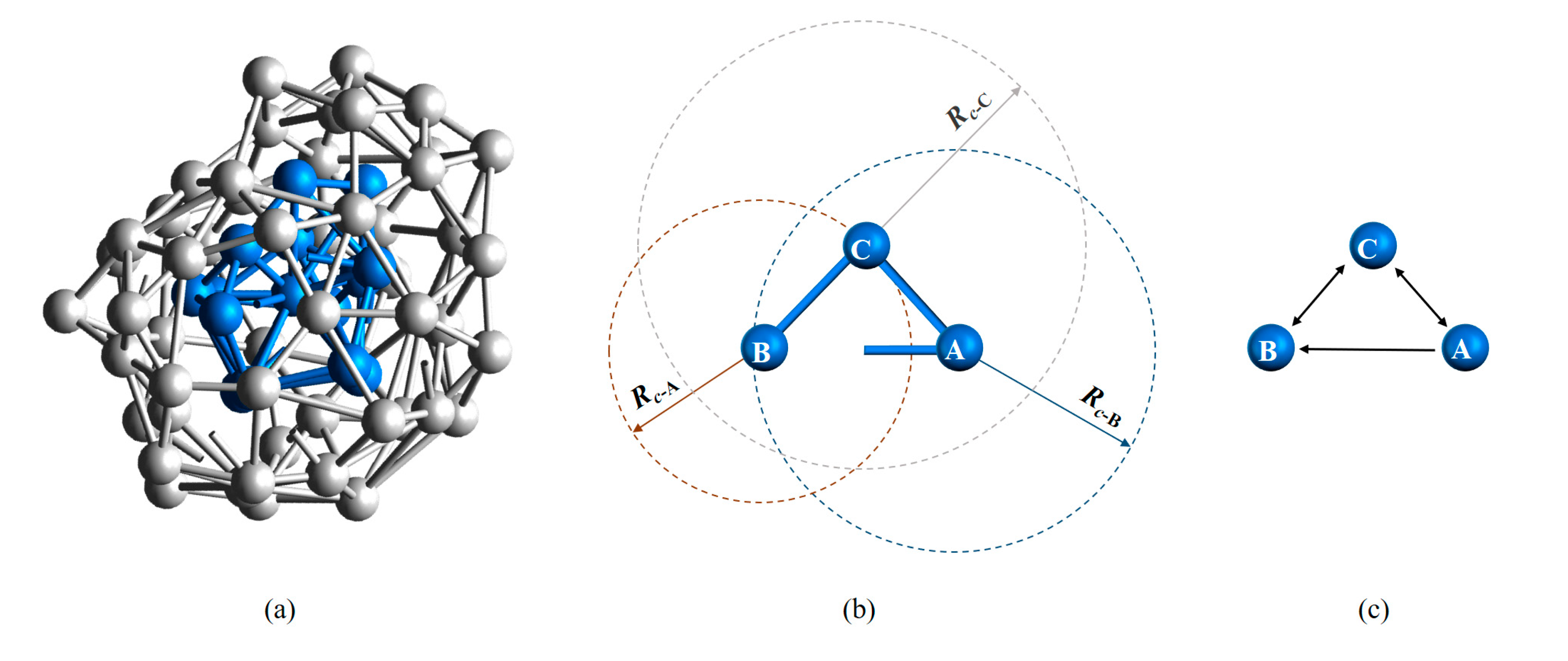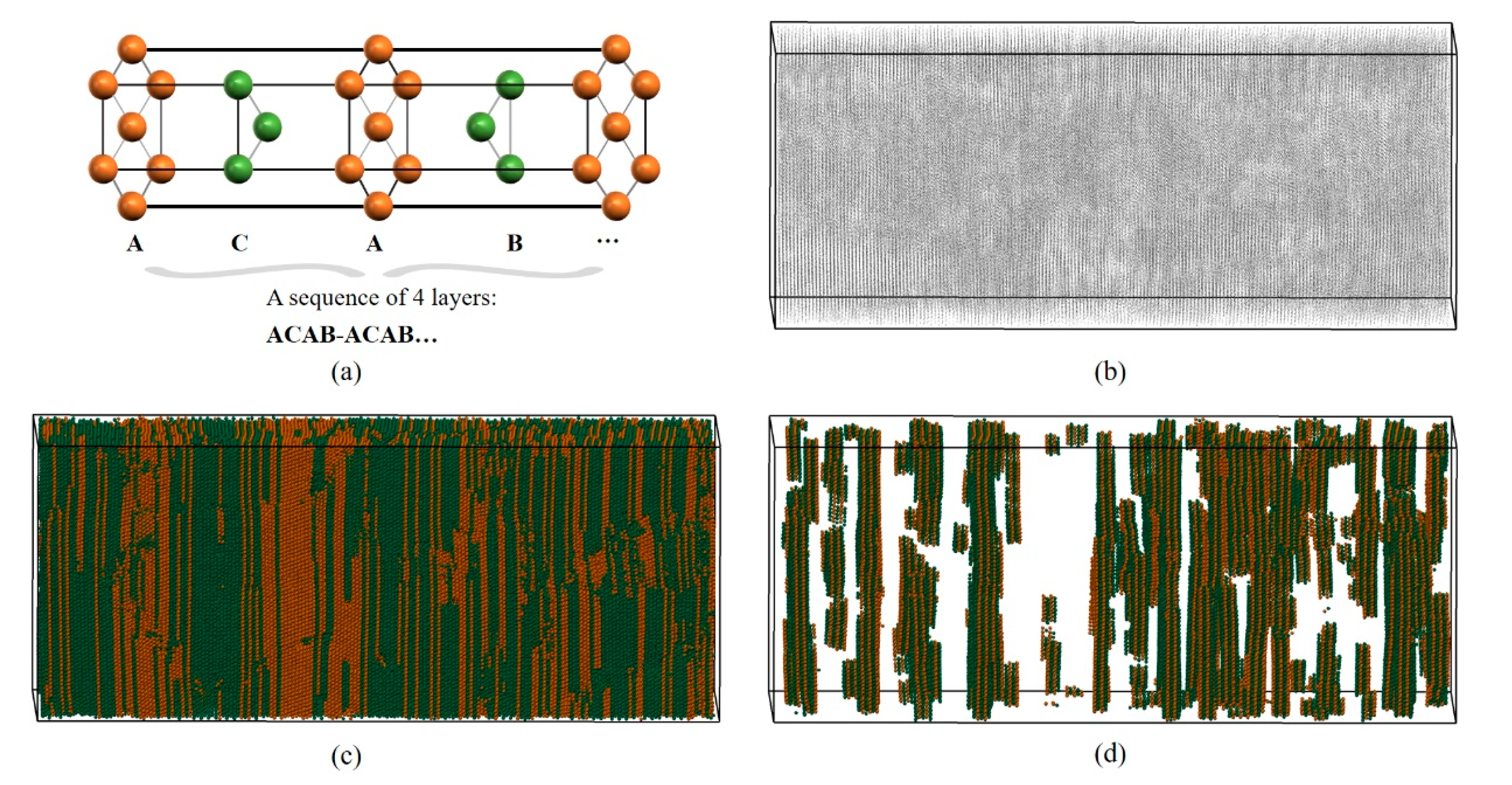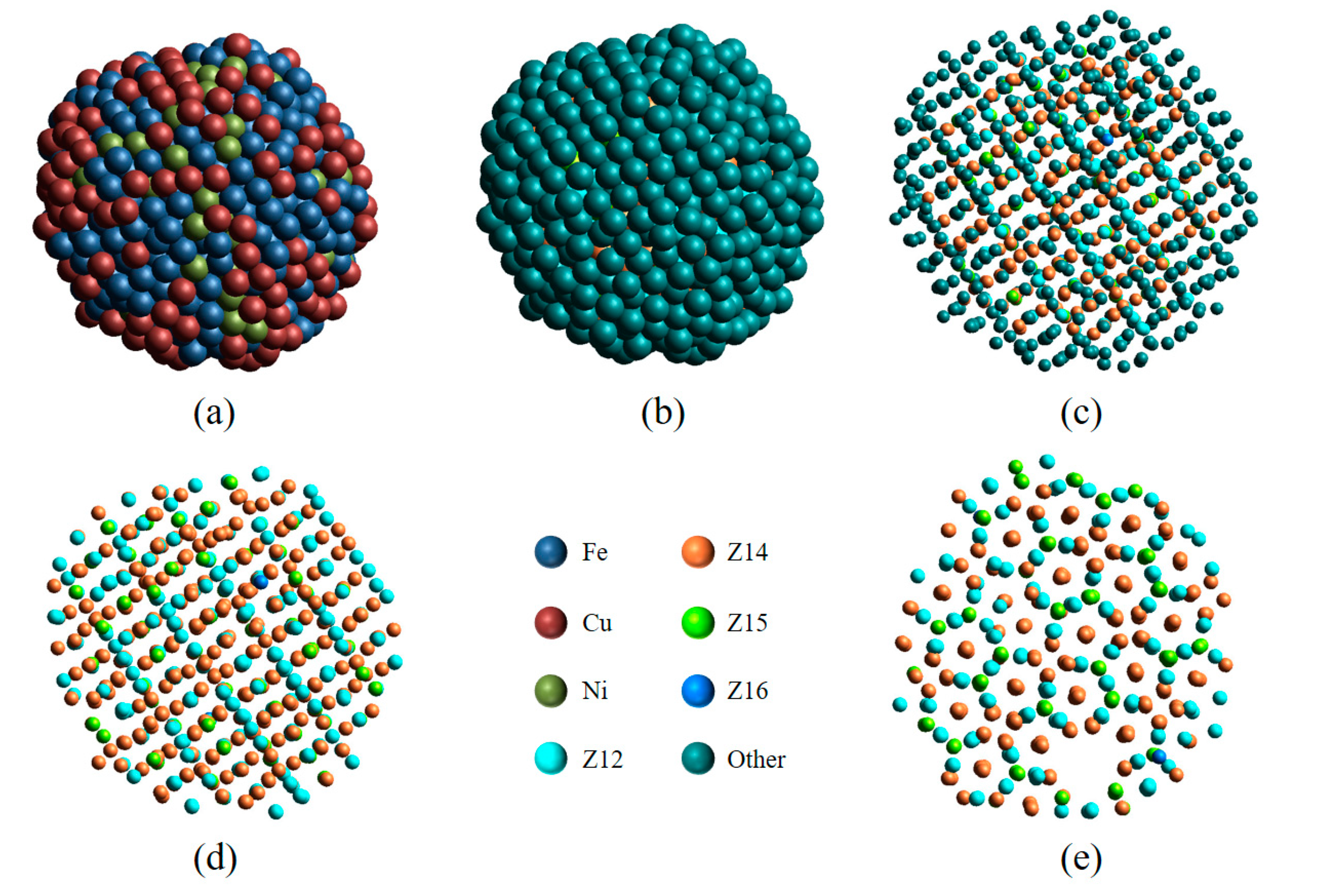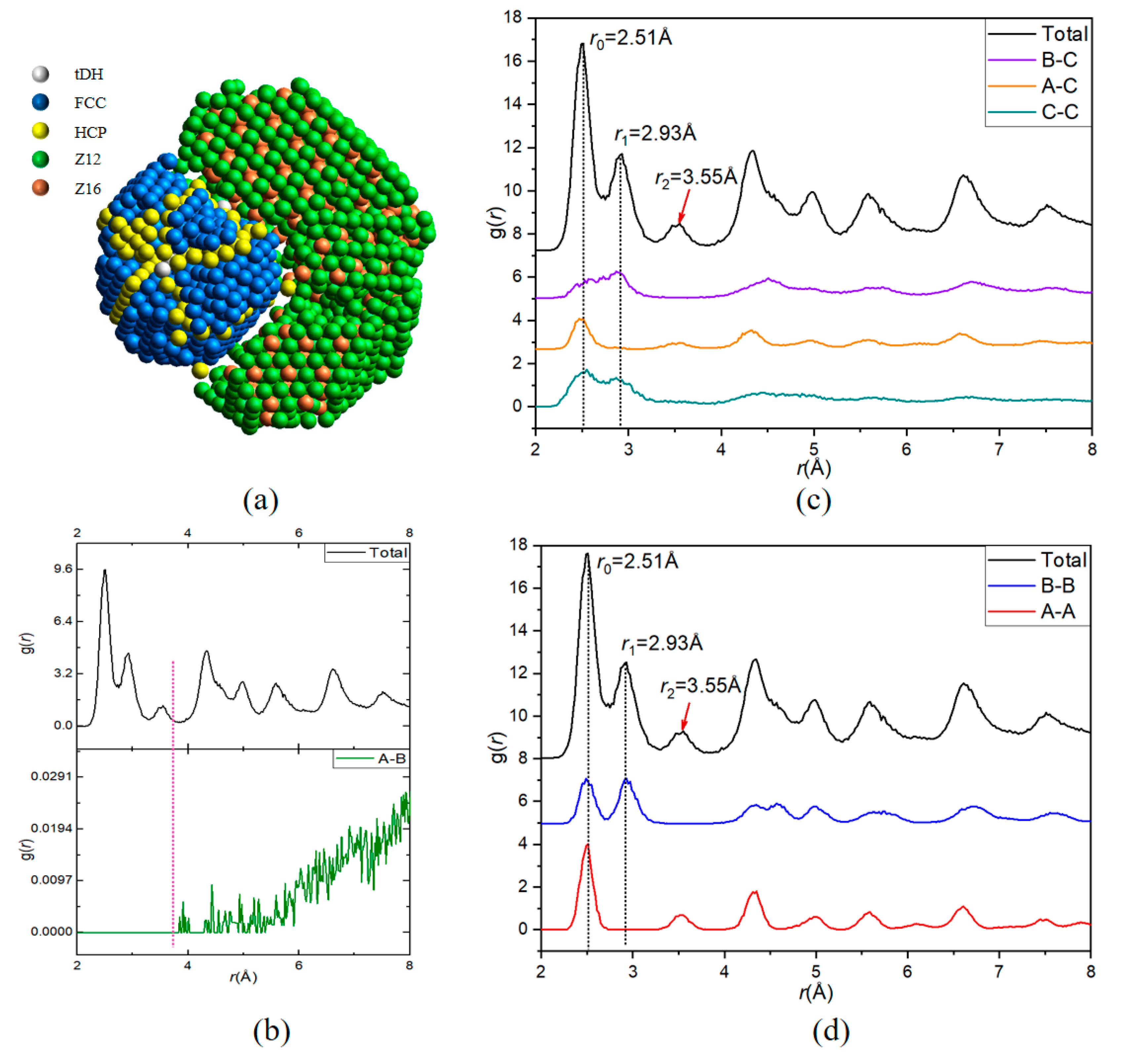LaSCA: A Visualization Analysis Tool for Microstructure of Complex Systems
Abstract
1. Introduction
2. Core Concepts
2.1. Basic Requirements for General Structural Analysis
2.2. The Basic Logic of LaSCA
3. Specific Features of LaSCA
LaSC-Based Visualization Analysis
- Atom representation automatically switches according to the number of atoms to be displayed, from sphere through icosahedron and tetrahedron to point. This is so that the rendered image is presented as quickly as possible.
- The atom’s ID can be displayed and tracked visually. Not only are the ID numbers always facing the user when rotating and transforming, but their size and color can also be configured by users in various ways.
- A variety of ways are available to help users obtain a suitable viewing angle. Users can customize (fix) the rotation axis (OX, OY, OZ, and any axis); when a section is displayed, a “vertical observation” shortcut is provided.
- Long-range ordered structures can be identified with topological criteria. Currently, there are several complex crystals consisting of hexagonally densely packed (HCP) layers, such as double HCP and rhombic crystals.
- Logical OR can be implemented by selecting multiple items after an attribute has been discretized into multiple intervals (items), logical AND is achieved through pipelined operations, and logical NOT is also supported.
4. Case Study
4.1. Long-Range Ordered Structure
4.2. Visual Analysis of Complex Crystal
4.3. Partial PDF Analysis of Multi-Component Alloys
5. Discussion
Supplementary Materials
Author Contributions
Funding
Data Availability Statement
Acknowledgments
Conflicts of Interest
References
- Juhás, P.; Cherba, D.M.; Duxbury, P.M.; Punch, W.F.; Billinge, S.J.L. Ab initio determination of solid-state nanostructure. Nature 2006, 440, 655–658. [Google Scholar] [CrossRef] [PubMed]
- Streitz, F.H.; Glosli, J.N.; Patel, M.V. Beyond Finite-Size Scaling in Solidification Simulations. Phys. Rev. Lett. 2006, 96, 225701. [Google Scholar] [CrossRef] [PubMed]
- Cliffe, M.J.; Dove, M.T.; Drabold, D.A.; Goodwin, A.L. Structure Determination of Disordered Materials from Diffraction Data. Phys. Rev. Lett. 2010, 104, 125501. [Google Scholar] [CrossRef] [PubMed]
- Faken, D.; Jónsson, H. Systematic analysis of local atomic structure combined with 3D computer graphics. Comput. Mater. Sci. 1994, 2, 279–286. [Google Scholar] [CrossRef]
- Qi, D.W.; Wang, S. Icosahedral order and defects in metallic liquids and glasses. Phys. Rev. B 1991, 44, 884–887. [Google Scholar] [CrossRef]
- Honeycutt, J.D.; Andersen, H.C. Molecular dynamics study of melting and freezing of small Lennard-Jones clusters. J. Phys. Chem. 1987, 91, 4950–4963. [Google Scholar] [CrossRef]
- Aste, T. Variations around disordered close packing. J. Phys. Condens. Matter 2005, 17, S2361–S2390. [Google Scholar] [CrossRef]
- Jonsson, H.; Andersen, H.C. Icosahedral Ordering in the Lennard-Jones Liquid and Glass. Phys. Rev. Lett. 1988, 60, 4. [Google Scholar] [CrossRef]
- Polak, W.Z. Efficiency in identification of internal structure in simulated monoatomic clusters: Comparison between common neighbor analysis and coordination polyhedron method. Comput. Mater. Sci. 2022, 201, 110882. [Google Scholar] [CrossRef]
- Tuceryan, M.; Jain, A.K. Texture Segmentation Using Voronoi Polygons. IEEE Trans. Pattern Anal. Mach. Intell. 1990, 12, 211–216. [Google Scholar] [CrossRef]
- Jones, T.R.; Carpenter, A.; Golland, P. Voronoi-Based Segmentation of Cells on Image Manifolds. In Computer Vision for Biomedical Image Applications; Liu, Y., Jiang, T., Zhang, C., Eds.; Lecture Notes in Computer Science; Springer: Berlin, Heidelberg, 2005; Volume 3765, pp. 535–543. ISBN 978-3-540-29411-5. [Google Scholar]
- Tian, Z.A.; Liu, R.S.; Dong, K.J.; Yu, A.B. A new method for analyzing the local structures of disordered systems. EPL 2011, 96, 36001. [Google Scholar] [CrossRef]
- Wang, S.Y.; Tian, Z.A.; Dong, K.J.; Xie, Q. Inconsistency of neighborhood based on Voronoi tessellation and Euclidean distance. J. Alloy. Compd. 2021, 854, 156983. [Google Scholar] [CrossRef]
- Li, H.L.; Karina, A.; Ladd-Parada, M.; Späh, A.; Perakis, F.; Benmore, C.; Amann-Winkel, K. Long-Range Structures of Amorphous Solid Water. J. Phys. Chem. B 2021, 125, 13320–13328. [Google Scholar] [CrossRef]
- Zhou, L.L. Pressure effect on structure and properties of rapidly cooled Mg70Zn30 alloy. J. Mater. Sci. 2021, 56, 4420–4432. [Google Scholar] [CrossRef]
- Mo, Y.F. The short-range order in liquid and A15 crystal of zirconium. J. Non-Crystalline Solids 2019, 513, 111–119. [Google Scholar] [CrossRef]
- Jiang, M.X.; Tian, Z.A.; Xie, Q.; Gao, T.H.; Liang, Y.C.; Chen, Q. Numerical recognition of C15 unit in rapid solidification Ni70Ag30 nanoparticles. Acta Phys. Sin. 2022, 71, 176402. [Google Scholar] [CrossRef]
- Pennington, W.T. DIAMOND– Visual Crystal Structure Information System. J. Appl. Crystallogr. 1999, 32, 1028–1029. [Google Scholar] [CrossRef]
- Mendelsohn, L.D. ChemDraw 8 Ultra, Windows and Macintosh Versions. J. Chem. Inf. Comput. Sci. 2004, 44, 2225–2226. [Google Scholar] [CrossRef]
- Stukowski, A. Visualization and analysis of atomistic simulation data with OVITO–the Open Visualization Tool. Model. Simul. Mater. Sci. Eng. 2010, 18, 015012. [Google Scholar] [CrossRef]
- Tian, Z.A.; Dong, K.J.; Yu, A.B. Structural evolution in the packing of uniform spheres. Phys. Rev. E 2014, 89, 032202. [Google Scholar] [CrossRef]
- Tian, Z.A.; Dong, K.J.; Yu, A.B. Structural evolution in the crystallization of rapid cooling silver melt. Ann. Phys. 2015, 354, 499–510. [Google Scholar] [CrossRef]
- Radziuk, D.; Möhwald, H. Ultrasonically treated liquid interfaces for progress in cleaning and separation processes. Phys. Chem. Chem. Phys. 2016, 18, 21–46. [Google Scholar] [CrossRef] [PubMed]
- Luo, Y.C.; Tian, Z.A.; Zheng, Q.; Hu, L.; Dong, K.J. Crystallization insights revealed by simulation solidification study of Fe63Ni33Co4 alloy melt at subcritical cooling rate. J. Non-Cryst. Solids 2022, 586, 121557. [Google Scholar] [CrossRef]
- Hu, L. The role of TCP structures in glass formation of Ni50Ag50 alloys. J. Alloy. Compd. 2022, 897, 162743. [Google Scholar] [CrossRef]
- Li, J.J.; Tian, Z.A.; Xie, Q.; Xiong, S.X. Component effect on microstructure of rapidly cooled FeCuNi alloys. Chem. Phys. Lett. 2020, 753, 137630. [Google Scholar] [CrossRef]
- Frank, F.C.; Kasper, J.S. Complex alloy structures regarded as sphere packings. II. Analysis and classification of representative structures. Acta Cryst. 1959, 12, 483–499. [Google Scholar] [CrossRef]
- Wu, Z.Z.; Mo, Y.F.; Lang, L.; Yu, A.B.; Xie, Q.; Liu, R.S.; Tian, Z.A. Topologically close-packed characteristic of amorphous tantalum. Phys. Chem. Chem. Phys. 2018, 20, 28088–28104. [Google Scholar] [CrossRef]
- Li, X.; Tian, Z.A.; Xie, Q.; Dong, K.J. The topologically close-packed Fe70Cu15Ni15 nanoparticles—A simulation study. Vacuum 2021, 193, 110523. [Google Scholar] [CrossRef]
- Li, J.J.; Tian, Z.A. Structural Origin of the Second Peak Split of FeCuNi Metallic Glass. Low Temp. Phys. Lett. 2020, 42, 81–89. [Google Scholar] [CrossRef]
- Liu, B.B.; Chen, Y.C.; Guo, L.; Li, X.F.; Wang, K.; Deng, H.Q.; Tian, Z.A.; Hu, W.Y.; Xiao, S.F.; Yuan, D.W. Shock-induced phase transition in yttrium between multilayered hexagonal closedpacked structures by atomistic simulations. Int. J. Mech. Sci. 2023. submitted. [Google Scholar]
- Lang, L.; Deng, H.Q.; Tian, Z.A.; Gao, F.; Hu, W.Y.; Wen, D.D.; Mo, Y.F. The effect of Mo addition on structure and glass forming ability of Ni-Zr alloys. J. Alloy. Compd. 2019, 775, 1184–1198. [Google Scholar] [CrossRef]





Disclaimer/Publisher’s Note: The statements, opinions and data contained in all publications are solely those of the individual author(s) and contributor(s) and not of MDPI and/or the editor(s). MDPI and/or the editor(s) disclaim responsibility for any injury to people or property resulting from any ideas, methods, instructions or products referred to in the content. |
© 2023 by the authors. Licensee MDPI, Basel, Switzerland. This article is an open access article distributed under the terms and conditions of the Creative Commons Attribution (CC BY) license (https://creativecommons.org/licenses/by/4.0/).
Share and Cite
Tian, Z.; Zhang, Z.; Jiang, X.; Wei, F.; Ping, S.; Wu, F. LaSCA: A Visualization Analysis Tool for Microstructure of Complex Systems. Metals 2023, 13, 415. https://doi.org/10.3390/met13020415
Tian Z, Zhang Z, Jiang X, Wei F, Ping S, Wu F. LaSCA: A Visualization Analysis Tool for Microstructure of Complex Systems. Metals. 2023; 13(2):415. https://doi.org/10.3390/met13020415
Chicago/Turabian StyleTian, Zean, Zhongyang Zhang, Xiao Jiang, Feng Wei, Shen Ping, and Fan Wu. 2023. "LaSCA: A Visualization Analysis Tool for Microstructure of Complex Systems" Metals 13, no. 2: 415. https://doi.org/10.3390/met13020415
APA StyleTian, Z., Zhang, Z., Jiang, X., Wei, F., Ping, S., & Wu, F. (2023). LaSCA: A Visualization Analysis Tool for Microstructure of Complex Systems. Metals, 13(2), 415. https://doi.org/10.3390/met13020415






